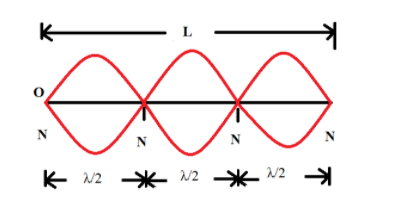
A standing wave pattern of amplitude A in a string of length L shows 2 nodes (plus those at two ends). If one end of the string corresponds to the origin and v is the speed of the progressive wave, the disturbance in the string could be represented (with appropriate phase) as:
Answer
495k+ views
1 likes
Hint: The solution of this problem starts with the usage of the standard equation of a standing wave, and then expressing the wavelength, the angular wave number and the angular wave frequency in terms of length of the string.
Formula Used:
Complete step-by-step answer:
The amplitude of a standing wave pattern = A
The length of the string = L
The total number of nodes = 2 nodes + 2 nodes at the end = 4 nodes
Therefore, the total number of nodes = 4 nodes
The speed of the progressive wave = v
A standing waveform diagram.

The end nodes will be present as the displacement will be zero at the both of the ends.
The nodes will be equidistant from each other. The distance between the two nodes will be
As the total number of nodes is 4, thus a total of 3 loops will be formed.
The equation of the standing wave is given by,
Where A is the amplitude of the standing wave,
k is the angular wave number denoted by
w is the angular frequency denoted by
Now we need to express the wavelength
As the distance between the nodes is
Therefore, the wavelength
As we have obtained the expression of wavelength in terms of the length, we will use the same to express the angular wave number in terms of length.
So, we get,
The wave frequency is the ratio of the wave velocity and its wavelength, so we have,
Substitute this wave frequency value in the expression of the angular frequency.
Again substitute the value of wavelength in this expression.
Substitute the equations (2) and (3) in (1), so we get,
Hence the required expression.
As, the disturbance in the string is represented by
Note: The things to be on your finger-tips for further information on solving these types of problems are: The total number of nodes formation should be taken care of, as the length of the string will be calculated in terms of the number of nodes formed and even the further calculation will be dependent on the length of the string.
Formula Used:
Complete step-by-step answer:
The amplitude of a standing wave pattern = A
The length of the string = L
The total number of nodes = 2 nodes + 2 nodes at the end = 4 nodes
Therefore, the total number of nodes = 4 nodes
The speed of the progressive wave = v
A standing waveform diagram.

The end nodes will be present as the displacement will be zero at the both of the ends.
The nodes will be equidistant from each other. The distance between the two nodes will be
As the total number of nodes is 4, thus a total of 3 loops will be formed.
The equation of the standing wave is given by,
Where A is the amplitude of the standing wave,
k is the angular wave number denoted by
w is the angular frequency denoted by
Now we need to express the wavelength
As the distance between the nodes is
Therefore, the wavelength
As we have obtained the expression of wavelength in terms of the length, we will use the same to express the angular wave number in terms of length.
So, we get,
The wave frequency is the ratio of the wave velocity and its wavelength, so we have,
Substitute this wave frequency value in the expression of the angular frequency.
Again substitute the value of wavelength in this expression.
Substitute the equations (2) and (3) in (1), so we get,
Hence the required expression.
As, the disturbance in the string is represented by
Note: The things to be on your finger-tips for further information on solving these types of problems are: The total number of nodes formation should be taken care of, as the length of the string will be calculated in terms of the number of nodes formed and even the further calculation will be dependent on the length of the string.
Latest Vedantu courses for you
Grade 10 | CBSE | SCHOOL | English
Vedantu 10 CBSE Pro Course - (2025-26)
School Full course for CBSE students
₹37,300 per year
Recently Updated Pages
Master Class 9 General Knowledge: Engaging Questions & Answers for Success

Master Class 9 English: Engaging Questions & Answers for Success

Master Class 9 Science: Engaging Questions & Answers for Success

Master Class 9 Social Science: Engaging Questions & Answers for Success

Master Class 9 Maths: Engaging Questions & Answers for Success

Class 9 Question and Answer - Your Ultimate Solutions Guide

Trending doubts
Give 10 examples of unisexual and bisexual flowers

Draw a labelled sketch of the human eye class 12 physics CBSE

Differentiate between homogeneous and heterogeneous class 12 chemistry CBSE

Differentiate between insitu conservation and exsitu class 12 biology CBSE

What are the major means of transport Explain each class 12 social science CBSE

Why is the cell called the structural and functional class 12 biology CBSE




